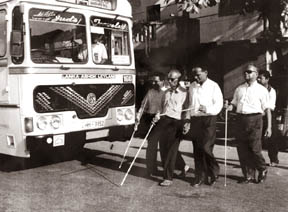|
observer |
|
|
|
|
|
OTHER LINKS |

|

|

|
|
Today is International White Cane Day: Significance of White Cane Day for the blind
“Clickety clack, clickety clack”... no, it’s not the sound of high heeled shoes of a fashionable lady. It is the tapping of a White Cane user - a blind person. The White Cane serves not only to identify the blind, it guides, it directs and protects the user. It is a multifaceted lifeline for the blind. Globally, October 15th each year is commemorated as White Cane Day. The origin of the White Cane is now traced to the end of the First - World War (1914-1918). Among the surviving War casualties there were a large number of visually handicapped persons. This had induced one Dr. Richard Hoover - a well-known medical doctor of the Lions movement in the United States to introduce a White Cane for the use of the American blind and visually handicapped. Others attribute the White Cane to a British photographer - James Biggs - who had gone blind. He found it difficult to get about in his work as a media photographer - especially to cross the road and avoid motorists. So Biggs painted his cane in white colour - because white was also the symbol of peace. Little by little use of the White Cane by the Blind and Visually Handicapped developed in the Western countries - especially the United States, England and France and individuals - especially from the Lions Clubs - and other social conscious organisations helped to popularise the use of the White Cane. The White Cane helps to identify a person as being blind or visually handicapped. It assist the user to clear a safe path ahead by diagonally tapping a Cane in a half-circle. It also assists to identify the surface on which the user is walking - whether hard or soft, rough or smooth. Further, by tapping the Cane on adjacent or adjoining structures or surfaces, such as walls, trees etc., the user is able to get some ideas of his location, bearings and direction. The White Cane also easily guides blind people up and down staircases. The White Cane provides the Blind the freedom to travel independently about their work and participate more fully in society. It has truly become not only a symbol of the blind but also a staff of their independence. Presently the White Cane is manufactured from light-weight Aluminium tubing. The price of a White Cane produced locally is between Rs. 200 to Rs. 250-. There are two well-established manufacturers of White Canes locally and their total production is around 2,000 per year. The standard size of a White Cane is 3 feet 9 inches (113 centimetres). The Sri Lanka Standard Institute has laid down specifications for the manufacture of White Cane. There is one main problem in Sri Lanka. White Canes are not freely available especially to blind persons in rural areas. Thus a blind person from the provinces is compelled to make a long journey to Colombo or spend a few hundred rupees to send a relation or friend to Colombo to obtain a White Cane. It is only during International White Cane Day in October, when provincial branches of the Sri Lanka Federation of the Visually Handicapped or Lions Clubs take supplies of White Canes to the outstations for distribution. It should be the responsibility of the Department of Social Services and the Provincial Ministries of Social Services to coordinate with the District and Divisional Secretaries and Grama Niladaris to ensure that White Cane users in rural areas have access to easily obtain a White Cane. The Sri Lanka Federation of the Visually Handicapped (SLFVH) is the only Organisation which has been annually commemorating this event in Sri Lanka since 1969, for 36 consecutive years. This year the SLFVH will mark this day with a series of events at the Public Library, Colombo 7, on 30th October 2006, commencing at 4.00 p.m. The event will be preceded by a “White Cane Walk” commencing from the Headquarters of the SLFVH, No. 74, Church Street, Colombo 02 at 2.00 p.m. On Sunday 15th October on “White Cane Day” itself, the SLFVH has teamed up with Orange Electric, Sri Lanka’s leading manufacturer and supplier of Electrical Products in putting up a massive Awareness Programme on the Blind titled “Empathy not Sympathy” at Parliament grounds at Battaramulla from 3.00 p.m. to 8.00 p.m. to which all members of the public are invited. It will also be an evening full of music and entertainment where the Blind and the sighted can mix freely as equals. The Lions Club of Nugegoda Central is also helping in this event. |








